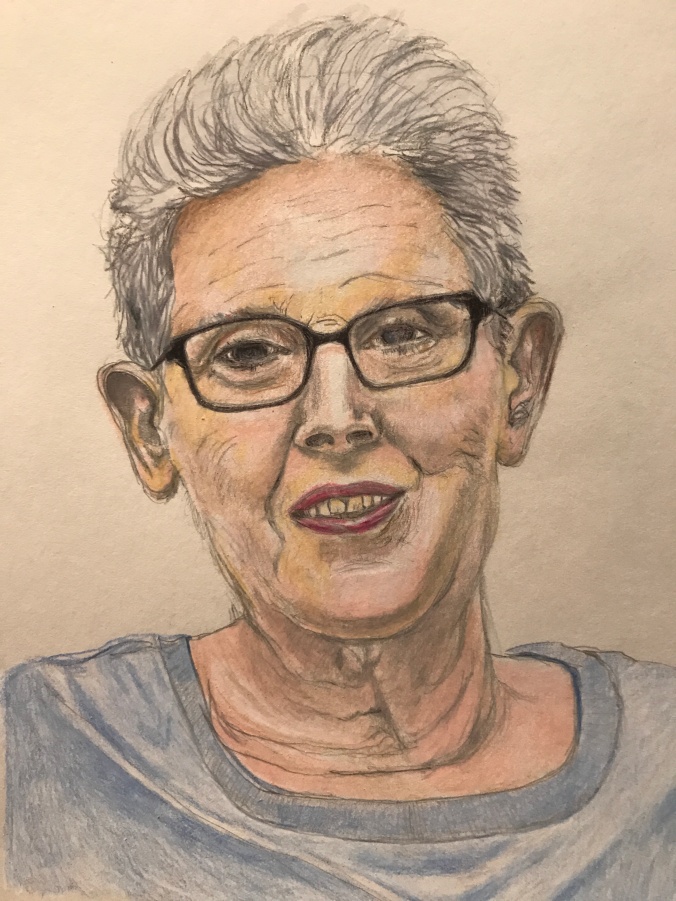 Portrait of Jeanne
Portrait of Jeanne
The regularity of Jeanne visiting on Wednesdays has formed a bond that goes beyond routine. She is my friend and confides in me, and I in her. Yes we play Scrabble. She brings food she has lovingly prepared. Where most people who I’ve been friends with have disappeared since this disease has progressed (including her sister Ruth who promised to be my friend until the end and ended our friendship by throwing me out of her apartment!), Jeanne is not that kind of a person. She practices acceptance. Kindness. She is a woman of her word. A woman of valor. Principled. I admire her honesty. The way she knows herself. Her generosity. Thoughtfulness. She’s rare in a world where people forget about others who need them. She still has friends from her youth. One is not doing well, and is in the throws of early dementia. She stays in touch with her and visits her. Jeanne does not forget. Her face radiates kindness. Honesty. This is what aging gracefully is like. The body going through it’s ordeals, but recovering. Alzheimer’s is not like that. there is no grace in it. Maybe it is for the people who progress extremely slowly in Alzheimer’s, there’s an opportunity to have a sort of glissando. But when it’s not mild and runs ragged over brain and body, as it’s doing to me, it affects everything. Behavior, cognition, executive function, sleep, speech, eating, swallowing. It’s impossible to grasp the severity of this experience unless you have known someone who had the disease. How can someone who is experiencing losing their mind, describe it, and still make art. It’s exactly what I do here.
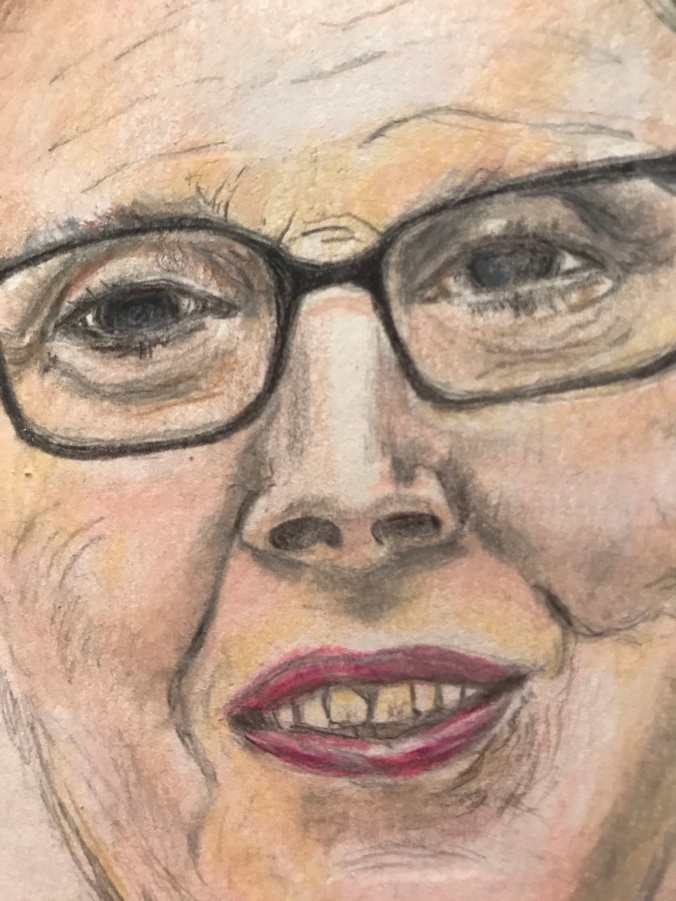
I had previously written about how heartbroken I was that I hadn’t heard back from a former colleague, an American history teacher I’d worked with and knew for twenty years, after I sent him an email pouring my heart out to him about how devastating having this disease is. In hindsight, my heartbreak was misplaced, because he did write back and offered as much insight as he could. He said that it pained him terribly to hear about the hand I have been dealt. This is a man who survived cancer and 12 rounds of chemotherapy when he was quite young. He’s a survivor. The truth in his words were this- “One can only try and live life to the fullest as best as one can, for as long as one can —and as life goes on one’s ability to do that, and what constitutes “life to the fullest as best as one can”, will inevitably change and be impacted by forces and conditions beyond our control”. These words ring true. Alzheimer’s and the deterioration it is causing me is beyond my control. I appreciate his frank honesty. His suggestion to look for solace in the Stoic philosopher’s Seneca, Epictetus, and Marcus Aurelius, was not so helpful. When I looked them up I couldn’t find any solace that applied to me, but it showed me that he understood that finding solace at the end of the day, or some way to deal with this, even for a few moments each day, is imperative. It’s that I have to search in my own way, which is to grasp and find the way to accept what impermanence and change means for me. The disease is taking away so much now. Yes. My mobility is decreasing, my balance is terrible, and I often feel like a lumbering beast. Most mornings. I lay in bed, unable to get up. My body hurts, my torso is stiff and my shoulders are in pain. My husband came into the bedroom on Monday morning at 11am and asked if I wanted to get up. I told him I was in pain, and he brought me a tea and two Ibuprofin. My hero. I swallowed them with the tea. It is frightening to witness how fast this illness is progressing now, and how much of the cognitive combines with physical decline. Alzheimer’s breaks down the body. My husband keeps me going when he is here. He makes sure I get out of bed, makes sure I eat. Does the food shopping, and cooks, takes care of the building, our house, his house, our home. He pays the bills, drives to work in another state three days a week, and hired a part time companion who has a great deal of patience, and a yoga teacher to work with me. He takes me for walks when he isn’t working. But the impact of caring for me, his wife who has Alzheimer’s disease, along with the strenuous jobs he does, is impacting greatly on his health. He has begun to see a therapist on Saturdays. It’s something. He says it’s better than nothing. It is so unfair that this disease happened, and it’s so unfair that it is not only killing me, but is also affecting him adversely. I’ve done what I can to minimize this but in this disease the ill person needs a lot of care, and that need increases and increases over time. He has become the reluctant caregiver. Very reluctant. I feel sorry for him but also I’ve been so angry with him for missing the best and strongest years, when he lived in Connecticut for 9 years and I had way too much responsibility and stress. I believe that all the stress contributed to my getting this at this age. It’s water under the bridge now. I am very ill and he is doing everything he can to keep me alive and not be bed bound, and out of the clutches of the nursing home reaper.
I came upon an article in the New Yorker written by a palliative (end of life care) doctor (Sumitra Puri, M.D.) called The Lesson of Impermanence. In it he wrote about how a chance encounter with a sand painting helped him learn to doctor patients he would lose. He became increasingly anxious and despondent, trying massages, therapy, hiking, meditation. But his sadness grew stronger. He searched for a community among others searching for support. He found a Vietnamese Buddhist temple a short drive from the hospital. There he whispered prayers asking to help find the strength and take away his sadness. One evening the temple’s main hall was unusually crowded. People had gathered around a table where they were creating a sand mandala. Metal cups filled with sand of every conceivable color lined one end of the table. The mandala’s circular shape symbolized both the cyclical nature of birth and death and the indestructible nature of the universe. The first evening the monks painted a flower with multicolored petals, the next evening the flower was surrounded by circles of deep blue and pink and rectangles of turquoise and gold. But the following morning when he looked in shock as one of the monks began to move a feathery brush over the mandala, swirling together the gold and blue, the circles and the rectangles, sweeping away his work just as methodically as he had placed the grains of sand in the same space. He cried because the hands that created it, were content to let it go. He wrote that the Bhagavad Gita which his father had read to him as a child, emphasizes that change is the law of the universe. The Vietnamese monk Thich Nhat Hanh reminds us that “impermanence does not necessarily lead to suffering. What makes us suffer is wanting things to be permanent when they are not. When he returned to the hospital the next day, he thought of the mandala as he sat with a breathless man his own age dying of lung cancer, and an agitated woman in the final stages of dementia. He felt compassion for them but didn’t leave that day consumed with grief. He accepted his patients’ circumstances rather than fixating on their inherent tragedy. He focused instead on changing what he could; easing breathlessness and agitation, explaining hospice services to their despondent families. The creation of the mandala and it’s being swept away, reminded him of the circularity of all things, of change as life’s only constant.
Wishing versus reality.
As I lay in bed coming out of the stillness of sleep, I imagine myself getting up and being normal again. Having strength. Walking normally. Speaking normally. Not thinking about how to get through each day. Not aware of everything as an obstacle that needs to be overcome. Not having to figure everything out. Not having to force myself to remember how to do things. Oh, how I wish for the ease of normality. The things people take for granted. As soon as I stand and walk, I have the jarring realization that my body no longer listens to me. I lurch. I lean. I use pieces of furniture to support me as I move around. I go slowly feeling like I will fall. Hold the banister and carefully descend the stairs. Turn up the heat as I am always freezing now. Turn it down because I start to sweat. Dis-regulation. My brain and body no longer belong to me.
A memory- I am getting off the #1 train (the IRT) in Manhattan at 79th street. I rush ahead through the turnstile and race up the steps. I am strong.
Three years ago. 2016. I was still strong. It’s like my brain and body said, “now you have reached your expiration date”.
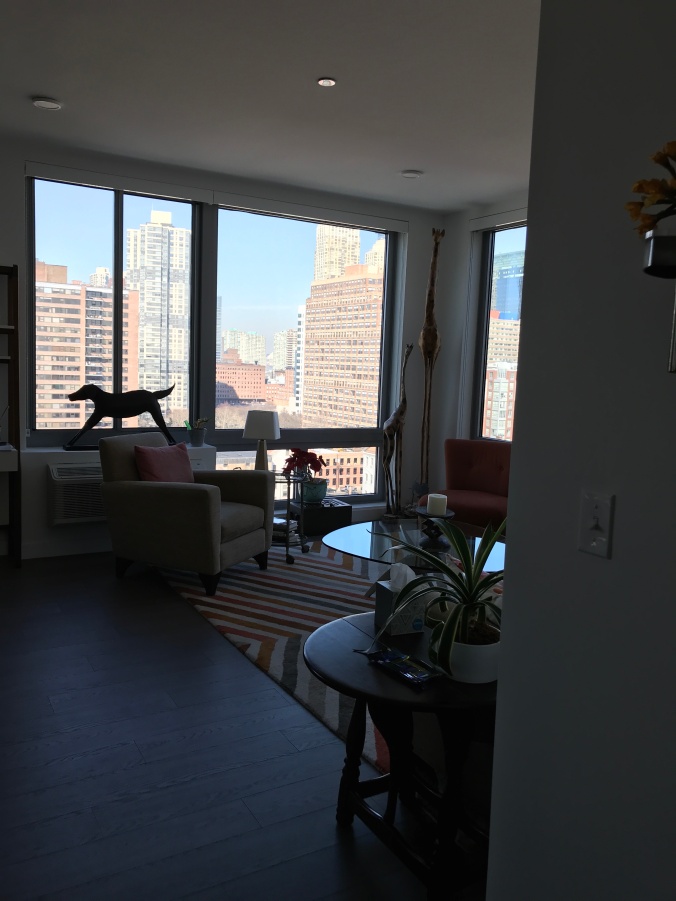
Dina and Todd’s living room
Boredom and depression are huge factors in this disease, and along with that comes so much anxiety, realizing that the life, strength and energy I need to do things is severely compromised. I want to go and do and see. But for me it’s too late to fulfill the bucket list. My trips are now local. Walks around my city. I have to be careful not to overdo. The other day, I walked with Theresa to the PATH train and back. I showed her the route I used to take all the time. Wanted to familiarize her with another part of this city. Taking the same 1.5 mile walk with her going North, had become so depressing. So we went downtown – set out for Hudson street, through Stevens park, across River street then down to Frank Sinatra Drive, and walked along the walkway beside the Hudson river. But I had a yoga session planned with Krishna, and we had to make it back in time. By the time we got back, I had walked almost 3 miles, and my feet were aching. The strangest anxiety was making me crumble. I felt it all over and it made me feel insane. I wanted to scream but didn’t. I layed out the yoga mat, and asked Krishna to massage my feet. His presence was calming. He instructed me to do some stretches on the mat. Every time I twisted or turned I felt like I would fall over. Finally the stretching and twisting soothed me. A few baby cobra postures, a few minor bends of my back. A long Savasana (corpse pose) in which one just lies on their back and breathes and does nothing. It troubled me to open my eyes and come back to a sitting position.
Dina who has been visiting me every few weeks, texted me last Friday, and asked if I was interested in coming to her apartment, along with her husband, Todd. Simply going anywhere causes anxiety now. But I wanted to go. This was an invitation. I don’t get invitations to go anywhere anymore, and I’ve been so bored sitting in my house. I wanted to experience something new, see where she lived, how she lived, see the things she surrounded herself with. So she and Todd picked me up, after they attended synagogue Shabbat morning. I was ready on time, and although my physical awkwardness made getting into the back seat of their car, and buckling the seatbelt hard, I was intrepid, doing it myself. Todd is 69 but is lithe and fit, and looks much younger. One of three brothers, he’s the one who has good fortune – health, happiness, prosperity, love. The younger brother, who was an ordained minister, had a major stroke and uses a wheelchair, can hardly speak and can’t write. The older brother has been having falls, and is also be in decline. I attribute Todd’s health and happiness to Dina, who is tall and beautiful at 52, and who he is obviously deeply in love with. He was married to someone else at age 19, and had two children, who are now in their late 40’s now. He divorced that wife and divorced that life. This is what may have saved him. He took the right path at the fork in the road. A professor of criminology, he met Dina who is around 17 years younger, and they had a daughter (who was my former student), who is now 18. They traveled the world together. He converted to Judaism, Dina’s religion at birth . He told me he likes the rules and structure of Judaism. To me he represents what is the New Jew. Not the ever suffering Jew (in Yiddish – “shvair tzu zein a Yid”- translation “hard to be a Jew”). Not the gefilte fish eating, Hebrew wailing, woeful G-d fearing Jew that is synonymous with my youth. Not the pious yamalke (scullcap) men with their long payis (the hair that grows in front of one’s ear between one’s forehead and the area behind the ear) walking with their wives who wear a shaitel (a wig or half-wig worn by some Orthodox Jewish married women in order to conform with the requirement of Jewish law to cover their hair as part of modesty related dress), along with their 5-8 children. He’s a New Jew. These are the best kind. People who recreate themselves because they choose to follow the faith from a need inside themselves. They choose to learn about the ethics of our fathers. He chose Judaism. I was born into a Holocaust family. A huge difference. Make way for the new. The Buddhist brushes away the intricately formed sand mandala because nothing is permanent, and former Christians make the best New Jews. Clean slate.
Dina showed me their art collection and I went with her from room to room, snapping photos. They have traveled with their daughter to Africa and many remote parts of the world. They have enjoyed raising her. She is an untroubled specimen. Brilliant in mathematics, languages, academically gifted. She questions. A whole person. This is what a good marriage brings, a child who grows up to become an untroubled adult.
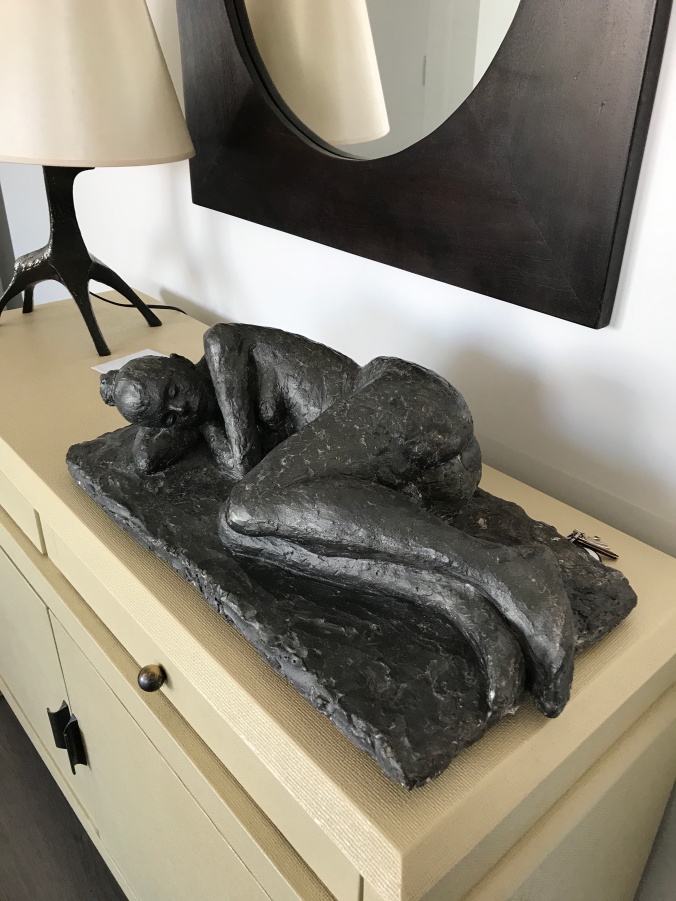 This is a sculpture of a reclining woman made by a female friend of Dina’s late mother.
This is a sculpture of a reclining woman made by a female friend of Dina’s late mother.
 A small seated bronze female figure by the same artist. Dina told me this her favorite piece.
A small seated bronze female figure by the same artist. Dina told me this her favorite piece.
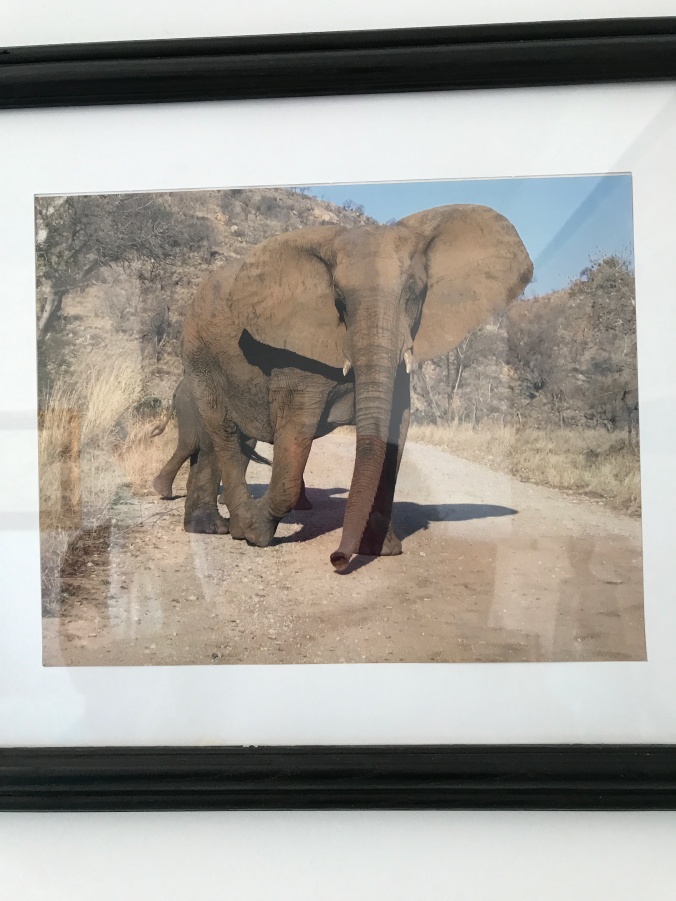 A photo Dina took of an elephant with it’s child, when they traveled to South Africa.
A photo Dina took of an elephant with it’s child, when they traveled to South Africa.
 A small elephant made out of cut pieces of Coca-cola and soda cans. This is typical of the recycled art made in South Africa of old tin cans and recycled products.
A small elephant made out of cut pieces of Coca-cola and soda cans. This is typical of the recycled art made in South Africa of old tin cans and recycled products.
 An assemblage made by their daughter when she was a child. Made from a soup ladle, a chop stick, a wash cloth, and a metal knitted scouring pad for hair (the same kind of scouring pads that my late father manufactured in his small shop in the Bronx when I was a child – I wrote about this last year).
An assemblage made by their daughter when she was a child. Made from a soup ladle, a chop stick, a wash cloth, and a metal knitted scouring pad for hair (the same kind of scouring pads that my late father manufactured in his small shop in the Bronx when I was a child – I wrote about this last year).
 An Egyptian painting of the goddess Isis on papyrus, hangs in their bedroom.
An Egyptian painting of the goddess Isis on papyrus, hangs in their bedroom.
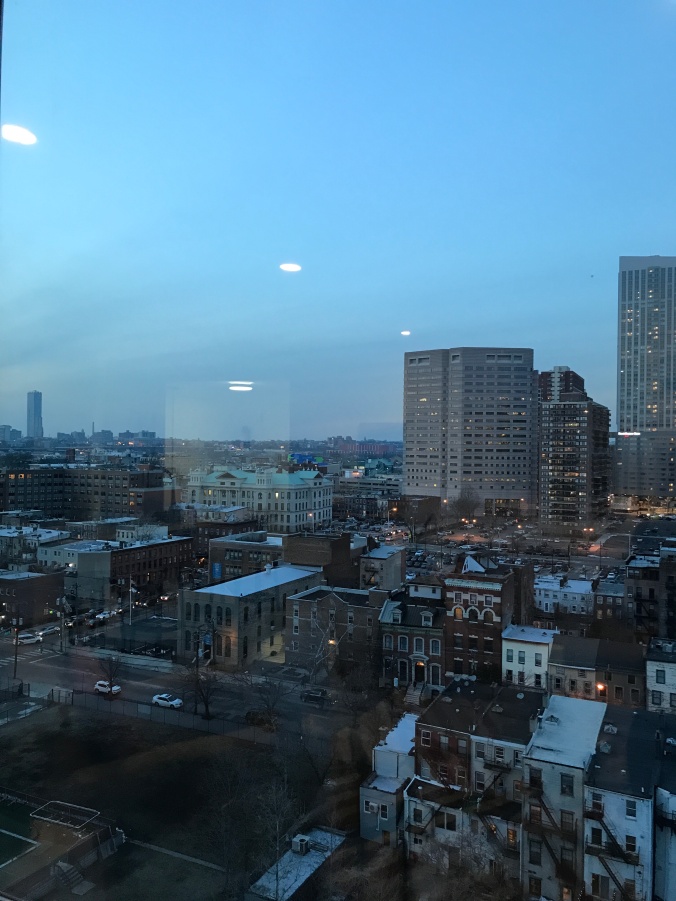

The views from the huge windows in their living room. One side looks out on Jersey City and faces West. The other side faces East, with views of Manhattan and the Hudson River. They will be moving to Montana in October. Their daughter will be going to university. I will miss them if I’m still around.
 My former student, David, whose mural I pass on the regular route, did write back to me, and has offered to visit. I warned him about what to expect. I am different, quite different. I snapped the photo of the right side of the mural which shows the old Maxwell House coffee sign. When I moved to this city over 40 years ago, they were still roasting coffee every morning and the whole town smelled like coffee. Now there is a vast condo development on the footprint where the Maxwell House coffee plant stood. Ruth who was my friend for eight months, but ended out friendship abruptly, lives in one of the apartments in the complex. I was happy to be greeted by her and have a friend to visit. Glad I could still walk there. I walk around this city now and remember who I was. Memories of taking my kids to the parks. Meeting friends at the restaurants. Listening to bands who became famous at Maxwell’s, the music venue/bar restaurant where Nirvana, R.E.M. and Oasis played. Where I heard The Bongos and Yo Lo Tengo. Where Bruce Springsteen used the restaurant as a stand-in for a Jersey Shore bar for his Glory Days video shoot.
My former student, David, whose mural I pass on the regular route, did write back to me, and has offered to visit. I warned him about what to expect. I am different, quite different. I snapped the photo of the right side of the mural which shows the old Maxwell House coffee sign. When I moved to this city over 40 years ago, they were still roasting coffee every morning and the whole town smelled like coffee. Now there is a vast condo development on the footprint where the Maxwell House coffee plant stood. Ruth who was my friend for eight months, but ended out friendship abruptly, lives in one of the apartments in the complex. I was happy to be greeted by her and have a friend to visit. Glad I could still walk there. I walk around this city now and remember who I was. Memories of taking my kids to the parks. Meeting friends at the restaurants. Listening to bands who became famous at Maxwell’s, the music venue/bar restaurant where Nirvana, R.E.M. and Oasis played. Where I heard The Bongos and Yo Lo Tengo. Where Bruce Springsteen used the restaurant as a stand-in for a Jersey Shore bar for his Glory Days video shoot.
Impermanence and change are the hard facts of life.
Unless you’re a Buddhist and accept change as life’s only constant.

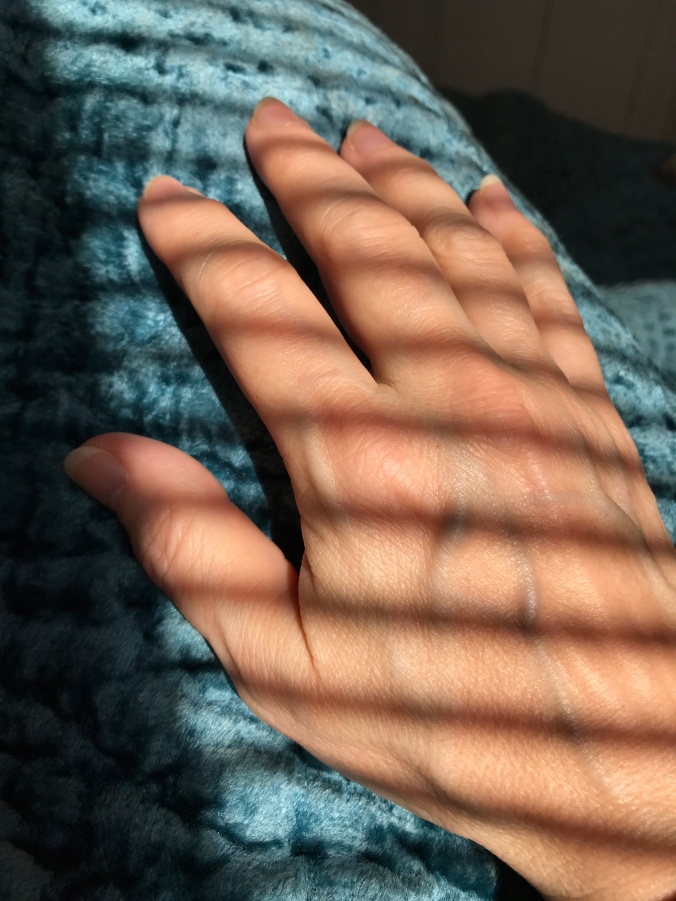
The drawings are beautiful…the eyes so expressive. How is the knitting coming???
LikeLike
Enjoyed your post. Am glad you heard from your colleague and student.
Lily
LikeLike
Lily your reply is brief. I know that you suffer from depression. What’s going on with you?
LikeLike
Hi Mina, thanks for your concern. I’m quite ok though a bit overtaxed with things. I’m not blessed with an over abundance of energy and go a few projects on the go, books to read, a needy dog…I hope you are doing ok and writing and arting. I’ve been on a sewing jag and haven’t drawn or painted for too long. I should get some pointers from you.
Lily
LikeLike
Thanks Judith for the complement.
As long as I keep developing the drawing and working on it, it does come to life. No crocheting (not knitting) for me this week. We did go to The Rubin Museum today and glad I did. Saw and participated in a wonderful interactive installation called The Wheel of Intentions http://rubinmuseum.org/events/exhibitions/the-wheel-of-intentions
Have a look.
Also saw a new exhibit called Faith and Empire: Art and Politics in Tibetan Buddhsm. It explores the dynamic historical intersection of politics, religion, and art in Tibetan Buddhism. Found out the amazing intricate tapestry made for the Mongol emperor was stitched in silk by young girls because they had such slender nimble fingers. http://rubinmuseum.org/events/exhibitions/faith-and-empire
Are you still painting? If you are do send me some images!
XX
M.
LikeLike
Great to see you at the Rubin yesterday. I enjoyed the honesty and the hopefulness in this post very much. It called to mind both the “radical acceptance” of impermanence and the power of intention. See you soon!
Rob
LikeLike
Hello Marti,
Once I get going the drawings do evoke something the character of the person. Glad I can still draw well and hope this continues. Thanks for the complement. Jeanne and her husband Bob like it too.
The intention I submitted on the interactive intentions project were the words, “My intention is to keep learning”.
LikeLike
Robert, glad to see you as well last Friday. I was psyched by the interactive Intentions project. My contribution was “to keep learning”. I was in the group with Laura and Audrey so missed your exuberant presentation. However, Audrey did a very good job and is improving as a docent. I made a comment about the porcelain pitcher on the 6th floor that is in the glass case. Laura said it’s in the shape of an inverted monk’s hat. I said that I thought this was the case because it is meant to show that the monk’s knowledge would be poured out of the pitcher to disciples. Both Audrey and Laura thought that was an extremely interesting observation, that they would never have thought have. My husband laughed and called this an example of my propensity to be an “idiot savant”. I think it’s that I still have insight.
I really like when you read and comment on my blog, so thanks for this and for your vibrant energy.
-Minna
LikeLike
Once again, Minna, your artwork amazes me! You certainly haven’t lost your gift with art. Thank you for sharing these beautiful pictures. I’m so glad to know your past co-worker did, in fact, write you back. I’m sure it was difficult for him to respond quickly but when he did it was heartfelt.
Even though you have a hard time getting up some days I’m happy to see you’ve been able to be with friends and go to their home and enjoy their company. They certainly think a lot of you and enjoy your company as well.
Alzheimer’s is a dreadful disease that changes daily. However, Minna, you are a fighter and remain diligent in keeping your writing and your artwork going and perservering as much as you possibly can. I so admire and love this about you.
The impermanence of each day is an unknown, something that’s out of anyone’s control. One thing I do know, because I saw this in my journey with my Mother, G-d is walking with you on this journey and while we don’t fully understand His ways, He has more beautiful plans than we could ever imagine.
Much love to you, Minna ~
LikeLike
Robert, glad to see you as well last Friday. I was psyched by the interactive Intentions project. My contribution was “to keep learning”. I was in the group with Laura and Audrey so missed your exuberant presentation. However, Audrey did a very good job and is improving as a docent. I made a comment about the porcelain pitcher on the 6th floor that is in the glass case. Laura said it’s in the shape of an inverted monk’s hat. I said that I thought this was the case because it is meant to show that the monk’s knowledge would be poured out of the pitcher to disciples. Both Audrey and Laura thought that was an extremely interesting observation, that they would never have thought have. My husband laughed and called this an example of my propensity to be an “idiot savant”. I think it’s that I still have insight.
I really like when you read and comment on my blog, so thanks for this and for your vibrant energy.
-Minna
LikeLike
Linda, I have to assume that your mother had later onset Alzheimer’s. Can you tell me when it started and what her trajectory was? Every story is different and I have younger onset which is very different from late age onset. This started when I was 61, and at a point when I was working/teaching/mentoring, weight training, and socially active. To my mind this came on suddenly, and I thought it was a relapse of major clinical depression. I had been off medications but thought that if I took antidepressants again, I would be fine. Instead, when I was put on Wellbutrin and Klonopin, the drugs disrupted synapses and threw me into a kind of psychosis. What I remember is that I was sleeping and woke up but continued to dream fragments of a dream while awake. This of course had never happened before. I attributed this to the drugs, and it was the drugs that caused it (especially the Benzodiazapines). When I tried to taper from the Klonopin which I was on for eight months, I started stuttering and became hyper-verbal. I had previously been a normal sleeper, had a normal sleep cycle. Once I was put on Klonopin, and tried to taper from it, and finally was detoxed from it in June 2016, my brain was damaged and the process and disease of Alzheimer’s took hold and began to progress. Before the medications I was always able to rebound. So in my case I believe this disease was in large part physician created and accelerated because I trusted psychiatrists. Of course it’s my journey so to speak and my hypothesis. I wrote an essay for Dementia Alliance International about this. In it I wrote, “A healthy brain rebounds from the assault of anticholinergic medications. A brain that is vulnerable may not have the capacity to do so. Paxil is a medication I was on for a long time. It is an anticholinergic which I have now found out, interferes with this neurotransmitter acetylcholine. I was put on benzodiazapines (sedatives) for anxiety. I used to have a perfectly normal sleep cycle. When the symptoms of anxiety and depression reared their ugly head I was put on new medications, including sedatives, even though I had a normal ability to fall asleep and stay asleep. I had what is called a paradoxical reaction to Klonopin, and my previously normal sleep cycle was destroyed. I went from being a 7 to 8 hour a night sleeper, to only being able to get 3-4 hours of broken sleep. Natural sleep is vital in clearing amyloid from the brain. Introducing anticholinergics into my system altered my autonomic nervous system. Plus Klonolin is highly addictive. Had I only known when I was prescribed benzodiazapines and SSRI’s and SNRI’s that there is now suspicion that these drugs can cause neurodegeneration, I would not have taken them”. https://www.dementiaallianceinternational.org/minnas-story-dementia-and-ptsd/
Wish I could embrace your words about G-d walking with me and beautiful plans he has for me. I used to feel that way when I was well. I was a believer. Alzheimer’s has tested my faith beyond measure. When one is well it’s easy to believe. When one get’s very sick and there is no hope for recovery, it is very hard to hold onto faith. I am being honest with you. I hope that you can understand this.
-Minna
LikeLiked by 1 person
Minna, my mother was in her late 60’s when she was diagnosed. My father had suspected dementia but he passed away before my mom was diagnosed.
I went through a trying time with my mom’s doctor, at the facility she was living in, because she kept saying she needed certain drugs for her anxiety, depression and outbursts. The more drugs she was on the worst she got until finally I put my foot down & said “no more!” She ended up going to a psych ward to wean off all the medications. The irony of all of this is my mother never took medication except for blood pressure. Never had she had narcotics & it had an opposite affect on her. The psychiatrist was appalled she was on so many different drugs. After removing her from everything we started out with just one medication to help her with back pain. She was totally different, more engaging, still non-verbal, but could still communicate in her own way. I got rid of that doctor and used a hospice doctor who was an angel.
I agree with you when you said these drugs you were on have caused unnecessary damage, I truly believe some of these drugs exacerbate brain deterioration and some even say not to give to people with dementia. That’s one of things that happened with my mom.
Minna, I can’t begin to imagine what you’re experiencing, but what I do know G-d will never leave us or forsake us. We have to keep the faith even in the most horrific times in our lives. He loves us with a love we can’t comprehend, but we will know that love when we meet Him in heaven. I do understand what you’re saying and you have every right to feel this way. I will continue to keep you in my prayers.
Much love and light to you dear one.
Linda
LikeLiked by 1 person
Linda,
Thank you for telling me about your mother’s story and the meds she was put on. We concur that the psychiatrists and doctors often do more damage. It must have been traumatizing for her and you too to first put on drugs and then to be in a psych ward where they weened her from the meds. I wasn’t aware you wrote a book about her, To Helen With Love, until I researched and found this on Alz Authors, Good Reads and Amazon. I wrote for Alz Authors blog last year https://alzauthors.com/2018/07/31/welcome-minna-packer-author-of/
It’s a mystery what brought the dementia on in your mom, initially. Was it her blood pressure and the medication she was on to lower it? The carotid artery surgery may have spurred it on, as anesthesia often makes dementia progress.
You’re a special lady and your mom was blessed to have you so involved.
Blessings to you and appreciation for your prayers.
Minna
LikeLike
Minna — You created a beautiful portrait of jeanne. Thank you for the link to the intentions project at the Rubin Museum. Would you share your intention?
LikeLiked by 1 person
Hello Marti,
Once I get going the drawings do evoke something the character of the person. Glad I can still draw well and hope this continues. Thanks for the complement. Jeanne and her husband Bob like it too.
The intention I submitted on the interactive intentions project were the words, “My intention is to keep learning”.
LikeLiked by 1 person
Minna, we never were able to determine what caused mom’s dementia. But she had two sisters who both has Alzheimer’s later in life. So who knows!
LikeLiked by 1 person
You are an inspiration.
Blessings.
LikeLike
Reblogged this on Anniegoose's Blog.
LikeLike